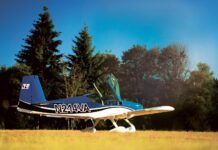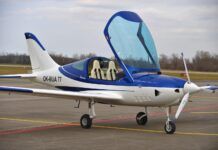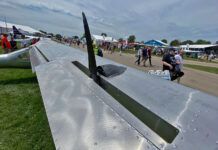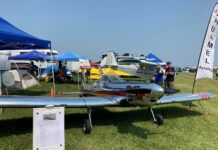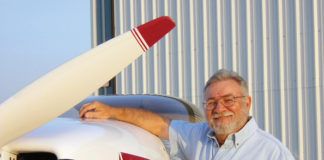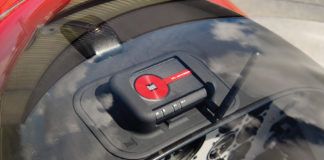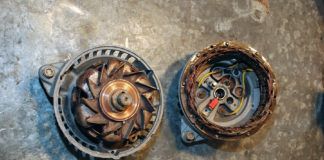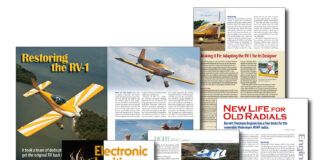Among lightplane manufacturers, its common knowledge that pilots generally favor the configuration in which they trained. Those who flew high-wing trainers, for example, tend to rent and buy high-wing airplanes. Regarding flight controls, nearly all civilian student pilots flew with a yoke for roll and pitch control once the post-WW-II trainers-the Piper Cubs and Aeronca Champs-ran out. Only fairly recently has it become common to find civilian pilots well acquainted with joystick flight time. The change no doubt relates to the popularity of homebuilts and Light Sport Aircraft (LSAs), most of which use stick controls.
Now there’s an SLSA (the factory-built, ready-to-fly version) that bucks the stick-control trend. Entrepreneur Paul Klomhaus of Oshkosh, Wisconsin, thinks that a lot of potential customers for his Eagle Aviation EA-100 SLSA will find that its high-wing configuration and yoke controls immediately fit their comfort zone. After flying the EA-100, I believe hes right.
Manufacturing and Maintenance Issues
The all-metal EA-100s major components are built by IBIS SA near Calle, Colombia, which makes three sheet-metal airplanes including another two-seater and a four-seater. EA-100 parts are shipped to Oshkosh, where Klomhaus and his staff at Wittman Field assemble the aircraft including engine, instrument and avionics installations. The company also adds approved custom touches.
Eagle Aviation is listed with the FAA as the manufacturer, which Klomhaus says is important to minimize the time and complications relating to repairs and major maintenance. Thats because the ASTM consensus standard for SLSAs requires the manufacturer to specify who can maintain and repair what on each aircraft, and only the factory may authorize repairs not specifically noted in the maintenance manual.
For example, on the EA-100, owners are approved to perform some maintenance (changing oil, spark plugs and tires are on the list) as they would be for a standard Part 23-certified aircraft. The manual allows maintenance and minor repairs to be accomplished by a licensed A&P mechanic, and other actions including the annual condition inspection may be done by credentialed light-sport inspectors (the people who have taken an approved two-week maintenance and inspection course). The maintenance manual, which is supplied to every EA-100 buyer, requires consultation with the factory for significant repairs.
The Airplane
With a few exceptions, the EA-100 is a thoroughly conventional airplane, using proven concepts and systems. The design features a steerable nosewheel, disk brakes and toebrakes on both sides of the cockpit. The cockpit is roomy, and Klomhaus says he has flown comfortably with pilots up to 6 feet 5 inches tall. The seatbacks recline, and leather-covered seats are optional as is cabin heating. Zinc chromate corrosion proofing is standard throughout the airframe.
One unusual feature is that the buyer has a choice of four engines: fuel-injected Subarus with 115 or 140 horsepower and 900-series Rotaxes with 100 or 115 hp turbocharged. The 140-hp Subaru is essentially the 115-hp version with addition of a failsafe supercharger. Only those who fly at high elevations or on floats really need the extra power, Klomhaus says.
The basic day-only, VFR airplane, labeled the Sport model, lists at $77,995 with the 115-hp Subaru. Choosing any of the other three engines will add $6500, $14,495 or $25,595, respectively. So far, customers have ordered the 115-hp Subaru, the least expensive option. Initially, fuel capacity was listed as 32 gallons, but production EA-100s will now feature 38-gallon tanks.
A second choice is the Deluxe (day/night VFR) version for $95,795; the Deluxe EFIS model sells for $105,395. The two higher-priced EA-100s add various levels of avionics and instruments. The Deluxe EFIS EA-100 includes an Op Tech EFIS with an 8.4-inch screen, Garmin radio and transponder, an engine monitoring system, and internal and external lighting. Wheelpants are an option on the Sport model but are included in the two higher levels. All three EA-100s include an intercom with a music input. They also feature electric pitch trim and electric flaps plus an unusual feature for a single-engine lightplane: rudder trim. Its electric, too.
The basic airplane color is white with two accent colors in a variety of paint schemes. Four-wheel amphibious floats are also available for $15,995. At this point Ill reveal one more significant option: Buyers may decide on control sticks instead of yokes, and there is no extra cost for this decision.
Flying
The airbrushed EA-100 on the flight line at last winters Sebring (LSA) Expo was one of the first built by Eagle Aviation, and it is powered by a 100-hp Rotax 912ULS. My flight with Klomhaus was in less than ideal conditions, but preflight, Rotax startup and taxi in a considerable breeze were routine. With half fuel and our combined weights, we were about 100 pounds under the maximum gross weight of 1320 pounds. Starting the takeoff into a left crosswind revealed easy effective control at low airspeed and a comfortable climb.
First impressions were that the controls are especially well balanced; similar force is needed on the yoke laterally for rolling into a fairly steep turn and aft on the yoke to maintain altitude. Similarly, pressure required on the rudder pedals for rolling into and out of turns while staying coordinated (keeping the slip/skid ball in the center) seems entirely appropriate to the forces required on the yoke. Visibility from the cockpit is good. A skylight allows looking inside a turn.
At cruise airspeed, rolling with full controls from one 45 bank to the opposite 45 took about 3 seconds, which is typical for LSAs. The EA-100 is positively stable in pitch; raising or lowering the nose and letting go gets back to trimmed airspeed and attitude in just over one rapidly damping cycle.
A partial-power departure stall came next at 36 knots and a really high deck angle. Releasing yoke back pressure immediately had us flying normally. We tried clean and half-flap approach stalls. These stalls, such as they were, came after a warning buffet at 36 and 28 knots, respectively. Slow flight at 55 knots was comfortable, and Klomhaus demonstrated that jerking the airplane around at this speed causes nothing exciting (but it might if you had a passenger rather than another pilot aboard). The 100-hp Rotax yielded the standard book value-105 knots indicated-at full power. Klomhaus says the Subaru 115 yields 115 knots, and the 140-hp Subaru makes the 120-knot LSA limit.
A normal airport pattern is flown at 80 knots, eventually slowing to 60 knots on short final with half flaps. Because of gustiness, we added some speed on our approach this time. The EA-100s published direct crosswind limit is 18 knots, but Klomhaus says hes done it safely in a 24-knot wind.
The EA-100s control feel is worth noting: All three axes require substantially more pressure than many homebuilts and other LSAs Ive flown. One way to describe this is to say that the EA-100 feels more like a Cessna 182 than a Vans RV. The airplane simply feels heavier and therefore more solid than some of the LSAs with lighter controls. Transitioning from Cessnas and Pipers to LSAs has been a challenge for some high-time pilots, and flying the EA-100 with its familiar feel may provide a higher comfort level than in lighter-handling aircraft. Klomhaus had a hand in designing the current version of the airplane, and he stressed the ease of learning to fly it well, either as a new student or as a transitioning pilot.
Yet numerous LSA accidents have resulted from high-time pilots failure to understand and compensate for the light wing loading of these aircraft. To meet LSA requirements such as the maximum clean stall speed of 45 knots, they need a relatively large wing area in proportion to their weight. If I were instructing in the EA-100, I would make sure there was plenty of crosswind landing experience before turning the student loose. The airplane is capable of handling all reasonable conditions, but some pilots arent.
Wrapping Up
The Eagle Aircraft EA-100 is a carefully built, especially nice flying SLSA with conventional systems (plus rudder trim) and stable, conventional lightplane feel. Its assembled in the United States, and it offers lots of options including engines and control configuration. Yokes or sticks: Have it your way. But if you want yours to look like an eagle in flight, Klomhaus says his airbrush artist needs a few weeks.
For more information, call 877/398-9541 or visit www.eaglesportplane.com.




